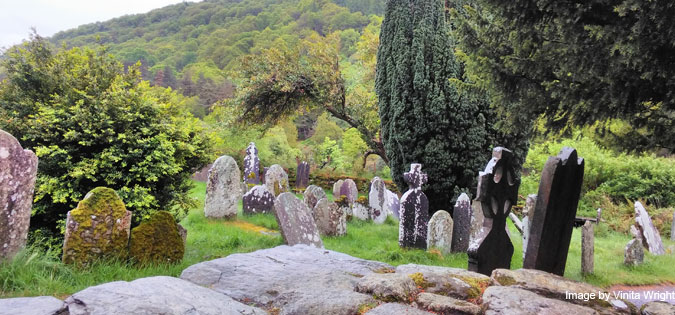
How does a person “do” pilgrimage? For someone like me, from the affluent, technological West, who spends so much of the day in her head, pilgrimage offers specific challenges. At each site, we were given ample information about its history and its impact on the Church. That was the easy part—taking in new information.
But true pilgrimage involves more than the mind. The purpose of physically traveling to a place is to experience it bodily. I stood in old graveyards and smelled nearby crops, felt the wind moving all around me, and heard birds, wind, conversations. My feet navigated uneven ground, ladders up high, ancient bell towers, and cold stone floors of pre-Christian tombs. As a pilgrim, I had to silence my thoughts and concentrate on the physical senses.
I believe that history has energy and that a site is made sacred (or not) by what has happened there. When I stand in the ruins of a church where spiritual masters taught and nurtured new believers, I am, in a mystical way, participating in that. When I look across hills and valleys from the spot where the ancient kings of Ireland were chosen and proclaimed, I am folded into that time—a time in which the Christian faith was moving through communities, without bloodshed for the most part, and influencing power, often in subtle ways. My sister-in-law, a midwife and nurse practitioner, did an additional walk to a place where babies were buried secretly because of shame or politics; there, she touched a root deeply connected to her profession.
Pilgrimage reveals not only knowledge and wisdom about the site itself but also knowledge and wisdom about the pilgrim who lingers at the site. God has designed history, geography, prayer, tradition, and our own gifts to mingle in places where there is a sacred meeting. This is how this marvelous world was designed—to present all sorts of connections and resonances to anyone who will pay attention.
We make pilgrimages all the time—to see family or visit a hometown; to tour the house of a favorite author or artist or spiritual teacher; to revisit a place that touched us profoundly, either with joy or pain. What journey will you make in the next month or year? Where can you linger—with your mind, memory, emotions, gifts, and sensuality—and connect with the graces God has hidden there just for you?
